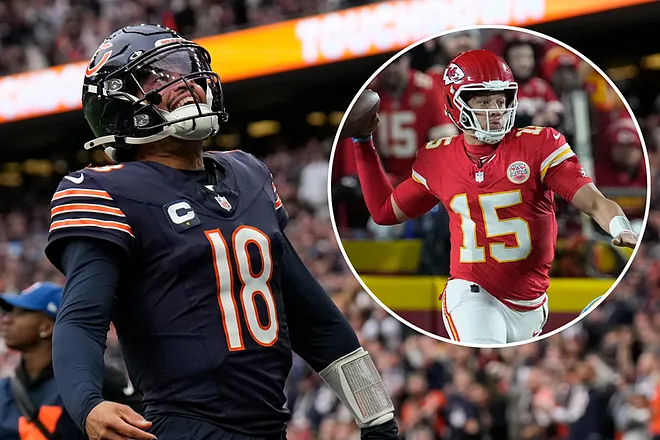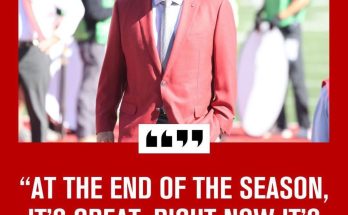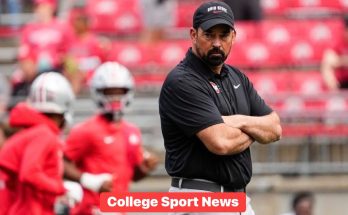In the ever-evolving world of the NFL, where the quarterback position defines franchises, the Chicago Bears have found themselves in a challenging position. Once a proud bastion of tough defense and iconic signal-callers, the Bears have struggled to find a true franchise quarterback in recent years. Enter Ben Johnson, the Chicago Bears’ offensive coordinator, who has a bold vision: to mold Caleb Williams into a quarterback of Patrick Mahomes’ caliber and, in doing so, raise the entire team’s level.
The Bears’ quarterback situation has been a revolving door of uncertainty. In the post-Mitch Trubisky era, the team has cycled through multiple signal-callers without finding the consistency and elite-level play that franchises covet. With a talented young head coach like Matt Eberflus and a front office eager to rebuild the offense, the focus has shifted to developing a star quarterback. Caleb Williams, the electric young talent from the college ranks, represents a beacon of hope in this endeavor. Williams arrived with considerable hype due to his outstanding collegiate performances—marked by his arm talent, mobility, and playmaking instincts. Now, with Ben Johnson at the helm of the offense, the Bears believe they can unlock Williams’ full potential.
Ben Johnson is not a name as widely recognized as some NFL offensive minds, but his reputation is steadily growing. As a young, innovative coordinator, Johnson brings a modern approach to quarterback development, blending traditional fundamentals with creative scheming. His ability to adapt his offensive game plan to the strengths of his players is a significant asset. Johnson’s philosophy is built around tailoring the offense to the quarterback’s skill set, not forcing the player into a rigid system. This adaptability is crucial for a player like Caleb Williams, whose dynamic style demands flexibility and room to improvise.
The comparison to Patrick Mahomes is not mere hyperbole. Mahomes revolutionized the quarterback position with his unique combination of arm talent, mobility, and football IQ, all while playing in a system crafted around his strengths under Andy Reid and offensive coordinator Eric Bieniemy. Ben Johnson’s goal is to do something similar with Williams: create a Bears offense that fully unleashes his capabilities, allowing him to thrive as a playmaker both inside and outside the pocket.
One of the core elements Johnson brings is an emphasis on building a relationship with the quarterback, one founded on trust and open communication. This relationship is critical because it creates an environment where the quarterback can experiment, make mistakes, and learn without undue pressure. Johnson understands that the transition from college to the NFL is steep, especially for a quarterback with such an improvisational style as Williams. The pace is faster, defenses are more complex, and the margin for error is much thinner. Johnson’s mentorship will be essential in helping Williams refine his decision-making, progressions, and mechanics.
Ben Johnson’s approach to quarterback coaching also includes meticulous film study and breakdown of opposing defenses. He encourages quarterbacks to anticipate rather than react—a hallmark trait of elite signal-callers like Mahomes. By instilling this forward-thinking mindset, Johnson hopes to elevate Williams’ ability to read defenses pre-snap and make quicker adjustments, which will be invaluable in the Bears’ offense.
Another crucial factor in turning Williams into a Mahomes-like player is the offensive scheme. Johnson is expected to implement a system that leverages Williams’ dual-threat ability, mixing designed runs, rollouts, and deep shots with a robust passing attack that uses quick reads and multiple options. The goal is to keep defenses off-balance and allow Williams to exploit mismatches. This scheme also includes a heavy dose of play-action and RPO (run-pass option) concepts to maximize the quarterback’s athleticism and decision-making under pressure.
The Bears’ roster surrounding Williams will be vital in this transformation. No quarterback, not even Mahomes, succeeds without weapons and protection. Chicago has been aggressive in the draft and free agency to bolster their offensive line and skill positions. With a strengthened offensive line providing Williams with the time he needs to operate, and a cadre of receivers and tight ends capable of stretching the field, the Bears offense will be designed to highlight Williams’ strengths. Johnson will work closely with the offensive line coach and skill position coaches to create a cohesive unit focused on maximizing the quarterback’s potential.
Moreover, Johnson’s role extends beyond just game planning and practice sessions. His ability to cultivate a positive culture around the quarterback is crucial. Williams, known for his competitive spirit and leadership, needs an environment that nurtures confidence and resilience. Johnson’s calm demeanor and focus on mental toughness will help Williams handle the inevitable ups and downs of a rookie or sophomore NFL season.
The parallels between Mahomes and Williams go beyond physical ability; both are natural leaders who inspire teammates with their work ethic and on-field vision. Johnson recognizes the importance of harnessing these leadership qualities to build a winning team culture. His vision includes Williams as the centerpiece of the franchise, not just a quarterback, but a leader who elevates everyone around him. By cultivating this mindset, Johnson aims to create a Bears offense—and ultimately a team—that is competitive year after year.
Of course, this transformation will not happen overnight. Mahomes had years of experience under Andy Reid before becoming the MVP and Super Bowl champion we know today. The Bears and Johnson understand that patience is necessary, but there is also a sense of urgency. The NFL is a results-driven league, and Chicago’s fans are eager for success after years of frustration. Balancing the need for immediate improvement with the long-term development of Williams is a delicate task, and Johnson’s experience working with young quarterbacks in various coaching roles gives him an edge in managing this process.
A crucial part of Johnson’s strategy will be incorporating modern technology and analytics into quarterback development. Film breakdown tools, virtual reality simulations, and advanced data analysis on defensive tendencies and player performance will be key components. Johnson’s embrace of these tools ensures that Williams will have every advantage available to accelerate his learning curve.
Furthermore, the Bears’ coaching staff has prioritized creating a supportive and collaborative environment. Johnson will be working alongside an offensive staff that values innovation, creativity, and player input. This synergy helps in crafting game plans that are not only effective but also empower Williams to play confidently and instinctively.
It’s worth noting that turning a talented quarterback into a franchise cornerstone involves more than just physical skill and coaching acumen. The mental and emotional aspects are just as important. The pressures of playing in a big market like Chicago, the expectations of a passionate fanbase, and the scrutiny from media can weigh heavily on young players. Johnson’s mentorship will focus on building mental resilience, emotional intelligence, and leadership skills to help Williams handle these challenges.
The Bears’ hope is that, under Johnson’s guidance, Caleb Williams will develop into a quarterback with Mahomes-level talent and impact—a player capable of making game-changing plays with his arm and legs, reading defenses with precision, and leading a franchise to sustained success. Achieving this will elevate not only the quarterback position but the entire Bears organization, from the offensive line to the receiving corps, to the coaching staff, and the fanbase.



